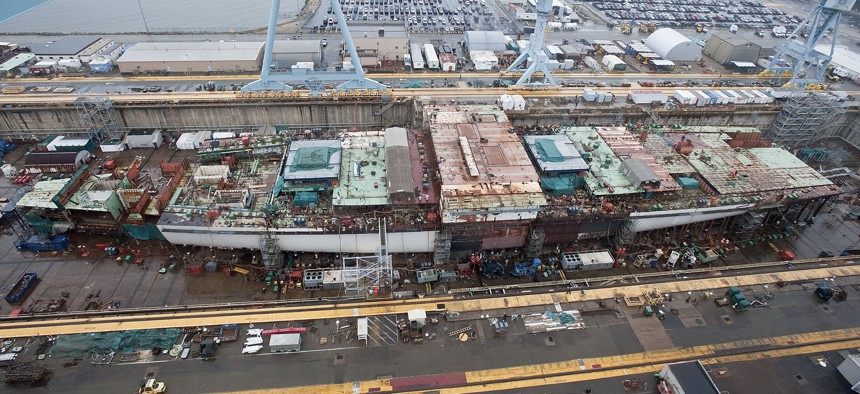
The aircraft carrier Gerald R. Ford (CVN 78), under construction at Huntington Ingalls Newport News Shipbuilding. U.S. Navy / Ricky Thompson
Five Myths About Pentagon Weapons Programs
As the service secretaries converge on Capitol Hill to talk acquisition reform, it’s important to sort fact from fiction.
There is an unfortunate array of mythological perceived wisdom in Washington about the development, testing, and production of America’s cutting-edge weapons. Here are five examples:
Myth 1: The defense acquisition system is broken. The United States has possessed the best-equipped military in the world for decades. The superior performance of its defense acquisition system helped bring the Soviet Union to defeat and allowed America to engage any adversary it has faced on conventional battlefields with decisive advantages. The defense sector of the U.S. economy has a strong positive trade balance largely because U.S. weapons are superior to those of our competitors.
Sustaining the U.S. position of military technological superiority over time requires that the acquisition system must take risks, and sometimes those risks result in cost overruns, schedule slips, and even canceled programs. This does not imply, however, that the system is broken. Creating a complex weapon system that is a generation more advanced than anything in existence is never a low-risk venture. That risk can be managed and mitigated, but it cannot be eliminated.
The defense acquisition system is far from perfect. There are many opportunities to improve efficiency, and the occasional dramatic program overrun or failure attracts significant attention, but to say the system is broken is just not supported by its overall history of success.
Myth 2: Excessive bureaucracy is the core problem with defense acquisition. There is certainly too much bureaucracy in the defense acquisition system. Bureaucracy is not, however, the reason that some programs experience cost overruns, schedule slips, and sometimes cancellations. Those problems arise because of errors in the substance of program planning and or execution. Bureaucracy is an overhead cost overlaid on the system.
The bureaucracy’s significant failing is that it does not always succeed in its purpose of preventing major problems. For example, the problems the F-35 encountered — excessive weight, software development delays, and numerous design flaws requiring correction — had nothing to do with the bureaucracy and everything to do with program planning and execution. A similar case is the CVN-78 Ford aircraft carrier program, in which problems with integrating several unproven subsystems led to massive cost overruns.
The bureaucracy associated with contracting and major program decisions is also not a primary schedule driver, for the simple reason that these processes are planned to accommodate a generally predictable and much more real schedule driver: the availability of appropriated funds. Bureaucratic processes are generally started so that they complete in time to support planned major events such as contract award dates, which are in turn controlled by the availability of funding. Repeated continuing resolutions and the threat of sequestration are much bigger problems for schedule execution and program stability.
Reducing the overhead costs associated with bureaucracy is a worthy goal, and that work should continue, but two things should be kept in mind. First, that the source of the bureaucracy is largely the U.S. Congress, which annually passes a National Defense Authorization Act that almost always increases bureaucracy by adding requirements that have to be implemented through regulations. Second, it is important to realize that bureaucracy is not entirely cost that adds no value — or more simply put: “Don’t throw the baby out with the bath water.” Many of the mechanisms put in place to implement and review program planning, monitor performance, and to support sound program decisions do have value, and do lead to improved planning and execution. Removing those mechanisms may marginally reduce overhead, but it will not improve planning or execution, and may well lead to poorer decisions.
Myth 3: Innovation is stifled by the acquisition system. The pace at which innovation moves through the system can be accelerated, but there is no shortage of creativity or new ideas, or access to cutting-edge technology in the defense acquisition enterprise. The combined efforts of Defense Department laboratories, defense industry, and organizations like the Defense Advanced Research Projects Agency are all focused on creating new and exciting options for U.S. forces. Outreach to commercial technology has always been conducted by government technologists and the defense industry. Competitive pressure continuously motivates defense companies to develop and acquire the best available technology.
There are two fundamental obstacles that impede the transfer of innovative technologies to our warfighters, often by consigning new ideas to the well-known “valley of death” between demonstrated technology and fielded capability. Those obstacles are the closely related lack of funding and the lack of formal operational requirements. The early experimental stages of technology maturation and experimental prototyping are inexpensive and do not require large long-term budgetary commitments or formal requirements from operational leadership. In the previous administration, a large number of experimental projects were funded. However, starting a major program that will lead to a significant fielded capability also requires a willingness to prioritize resources for that purpose and the decision by the military operational community to support a “requirement” for the new capability. These are the shoals upon which new ideas founder, not the department’s access to technological innovation. The defense acquisition enterprise does not control budgets or operational requirements; it responds to them. True innovation, which includes new operational concepts, will have to come through strong leadership beyond just the acquisition community, and importantly at the expense of other familiar and more traditional military service budget priorities.
Myth 4: Stronger “punishments” for cost overruns and schedule slips will lead to better performance. The assumptions behind this myth are that neither industry nor government program management is adequately motivated to do well, and that cost overruns and schedule slips can be reduced or eliminated through stronger financial incentives to industry and stronger disciplinary actions to program managers whose programs experience major problems. In fact, most contract arrangements do provide effective financial motivation. For example, development contracts that lead to production provide, on average, profit margins of about 6 percent. Production contracts provide margins at twice that rate. Doubling profitability is a strong motivator for any commercial company. Similarly, all the hundreds of government program managers I’ve ever known have been strongly motivated to keep their programs from becoming problem children or being canceled.
It is wishful thinking to imagine that we will get better results if we force defense companies to risk bankruptcy through contract mechanisms like firm-fixed-price development (definitely not a commercial practice) or if we threaten program managers with public firing. The more likely result of the more aggressive use motivational “sticks” is fewer companies willing to work for a Defense Department that exposes them to unbounded financial risk; and fewer qualified people willing to serve as government program managers who can be arbitrarily fired for poor program performance they had no real control over.
Myth 5: There is some new form of undiscovered “acquisition magic” that will fundamentally improve results. The quest for this elusive Holy Grail has taken many forms, going by names like “total quality management” or “reinventing government” or “transformation” or “total system performance” or “lead system integrator.” Some of these initiatives contained sound ideas and some led to marginal improvements; most had little effect or were actually quite counterproductive. The most recent form of acquisition magic appears to be something called “rapid acquisition,” which is generally understood as streamlined but high-risk acquisition that accepts lower quality products. Rapid acquisition has its place, primarily when operational urgency dictates the need to accept risk, accept waste, and get a basic capability lacking desirable but non-essential features to the field as quickly as possible. This was the case with the highly successful Mine Resistant Ambush Protected (MRAP) vehicle program to counter improvised explosive devices. One should remember, however, that of the roughly 30,000 vehicles produced at a cost of tens of billions of dollars, only a few thousand are still in the Department’s inventory; the rest have been scrapped or disposed of. Contrast this program to the more deliberate Joint Light Tactical Vehicle, or JLTV, which took much longer to field, but will serve the department for decades. Haste does make waste, and speed is not the only virtue.
After decades of searching for some new form of acquisition magic, it may be time to accept that the basics of fostering professionalism in both government and industry, developing sound requirements through close operator and acquirer cooperation, strong well-crafted incentives, and disciplined attention to detail, all embedded in a management approach of data-driven continuous improvement, represents the best route to improving defense acquisition.
NEXT STORY: The Iraq War and the Inevitability of Ignorance




